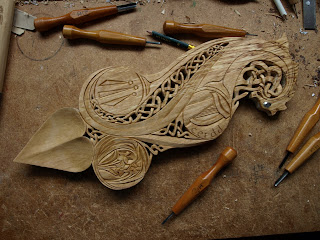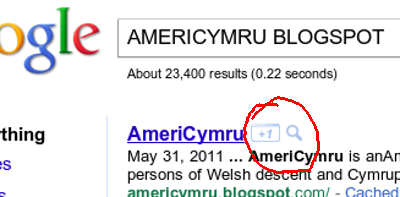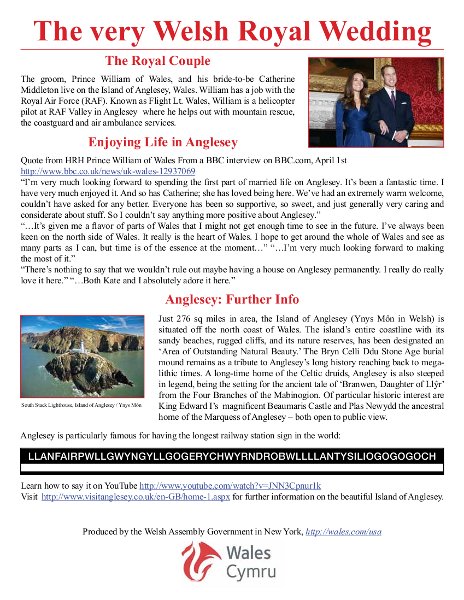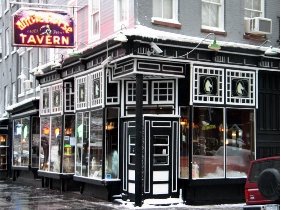
Recently Rated:
Stats
I've been beavering away on the sections of the Americymru spoon which our prize winning design ideas are to fill. Everything went very well and the front face of the spoon is almost completed! A bit of tweaking and some judicious shaving here-and-there is all that is required now!
I'm more than pleased with the beautiful grain and colourful figure of the birch used for this year's spoon. It is gorgeous stuff!! Like last year's spoon, the carving has gone very well and the wood seems to handle all the various design ideas without getting crumbly or cracking. I think itwill be a lovely spoon when it is done!
I really sweated about carving Laura's Daffodil design...both because we worked together on last year's spoon and I know how elegant and delicate she makes her flowers and because I decided not to fret cut through the design. Usually Laura's flowers have their surroundings cut away sothat they can stand proud without the weight of the background pulling them down. This year I didn't do that, so there was pressure on me to get the flowers nice and light and not have the background become too obtrusive. Hopefully, I've done it right and Laura will be happy with it.... otherwiseit is back to the drawing board for me!!! I positioned the Daffs design at the foot of the dragon's body so as to make a symbolic link with the ground. I also thought the earth makes the right metaphor for growth and that is what our Eisteddfods have been all about over these last 3 years!!
 The Harp design came out very well too! The harp seems nice and full and stands out clearly from the background with the text bringing some action to the big space on the right side of the circle. I think this design will certainly illustrate the importance of music both to the Eisteddfodand to the Welsh people. It's location at the Dragon's heart is also critical with the metaphor a simple and fairly obvious one!
The Harp design came out very well too! The harp seems nice and full and stands out clearly from the background with the text bringing some action to the big space on the right side of the circle. I think this design will certainly illustrate the importance of music both to the Eisteddfodand to the Welsh people. It's location at the Dragon's heart is also critical with the metaphor a simple and fairly obvious one!The Awen was another design I sweated over a bit. I was tempted to fret cut it out to really make it bold, but in the end I decided to stay with a very simple and elegant low relief carving. Because of its etherial nature, I felt it was ideally suited for the wing area of the dragon as it would have an association with flight and with other-worldliness (is that a word...it is now).
The Dragon's head is nicely set off with this lovely little piece of abalone inlay. (In case I am about to take a hammering from the environmental crowd for using abalone, I cut this particular piece from an old ashtray I found at the Salvation Army Store a few years back. It seemed a shame for something sobeautiful to be used for that purpose, so I have recycled, using it in dozens of spoons over the years.....besides, I don't even eat seafood!!!) The figure of the wood perfectly accentuates both the body and the back scales of our dragon and brings some extra zip to the Celtic knotwork....niiiice!!
So there it is so far! I hope that now you can see it is, indeed, coming along, you will be inspired to donate a few bucks to the Eisteddfod for your chance to win it!! Someone will be taking it home after the Eisteddfod (and no, you don't have to be present to win) so enter now and enter often!!!
Your donation (whether exceedingly generous or very close to the bone) will be used to make our Eisteddfod better and better!! Help hoist the Driag Goch amidst the sea of tartan and shamrocks that is Celtic North America!!!
If you've got a google account, google has unveiled a new recommendation system, Plus One.
To sign up and use plus one to help us tell the world about how awesome Wales is, first sign up for a gmail account at: http://gmail.com
Next, sign up for google plus one at: http://www.google.com/+1/button/
Last, google "americymru" and click the plus one button next to the title of the entry (see graphic below, in which I have helpfully circled it in red):
Use plus one to promote what you think is good, especially Wales and Welshness!
Read about Welsh elements in the Royal Wedding and the Prince's love of Anglesey:
The Royal Couple
"The groom, Prince William of Wales. and his bride-to-be Catherine Middleton live on the Island of Anglesey, Wales. William has a job with the Royal Air Force (RAF). Known as Flight Lt. Wales, William is a helicopter pilot of RAF Valley in Anglesey where he helps out with mountain resuce, the coastguard and air amublancer serices.
"I am very much looking forward to spending the first part of married life on Anglesey, It's been a fantastic time, I have very much enjoyed it and so has Catherine; she has loved being here. We've had an extremely warm welcome, couldn't have asked for better... So I couldn't say anything more positive about Anglesey.."
Read more here ( pdf ):- Welsh Royal Wedding
David Western's Lovespoon Blog 28 March 2011, "Last Week to Be Part of This Year's Spoon Design!"
By gaabi, 2011-03-31
There's only one week left in our 'help design the spoon' contest! So jump up off your backside, grab a pencil, unleash your creative 'inner-self' and sort out an entry or two - one of the easiest art projects you'll ever do. Seriously, the circles we need filling are only 2 inches in diameter each!! If you've been thinking about....its time to stop procrastinating and start scribbling! You could win a book AND the admiration of all and sundry!!!! C,mon...you can do it!!!!
If you have already entered...well done!! If you haven't...keep this one important thought in mind.....once we pick the winners, you'll never be able to say, "pfffft, I could have done waaaay better"....because frankly, you didn't!!!! So get in there, scratch out some lines and be part the fun!!!!
To motivate you, here's my contribution...none of which will appear on the final product even though I'm pretty pleased with the stylized Eagle and will definitely use it somewhere. The Beaver is pretty cool but any half-way competent NW Coast artist would likely only give me a C for effort and probably wouldn't be that impressed by my handling of line and form....and the stylized leek???? Well, it didn't exactly turn out like I hoped. SO, there you go, I've hung myself out there for all to see and now its your turn to enter some really motivated ideas and consign these to the bin.
From Dave's "editor": We'll choose the winning designs next weekend so this is your last chance to submit some Welsh designs, Celtic symbols or Celtic designs and to be part of creating this incredible piece of original Welsh-Canadian art. Winning designs will be part of Dave's creation and will be displayed at the West Coast Eisteddfod Welsh-American Arts festival in Los Angeles. Submit yours and be part of Welsh Arts and Welsh Culture at this year's West Coast Eisteddfod!
My kids and I found a BBC British history for kids page: http://www.bbc.co.uk/history/forkids/
which is actually pretty cool and materials are also available in Welsh. There are lots of activities on the page to print and do and links to history pages aimed at adults as well. We found this watching a youtube video for a kids show from the BBC "Hands on History."
Reprinted with permission from David Western's blog , all material 2011, David Western --
Nobody knows for sure where lovespoon carving originated, but strong traditions developed in Wales, Sweden and Norway and examples have been collected from most European countries. The oldest Welsh spoon was created in 1667 and is housed in the collection of the National History Museum of Wales at St Fagans near Cardiff. A German spoon dated 1664 is housed in the collections of the German National Museum in Nuremburg, and as far as I have been able to tell, is the oldest dated lovespoon currently known. It is unlikely that the custom dates back much further than the early 1600's despite wonderfully romantic theories of the custom having a direct link with the Celts of yore. Most of the romantic wood tokens originated around the same period and both the social and economic situation of earlier times make it unlikely they date back much before 1600.
It has been suggested that acceptance of a lovespoon was a betrothal promise, but this has never been proven and it is far more likely that acceptance of the spoon merely indicated mutual interest and a 'green light' for a courtship to begin.
Today, handcarved lovespoons are heirloom quality gifts which are given at engagements, weddings, anniversaries and a host of other occasions where a gift of deep sentiment is required. Although the symbolism may have changed throughout the years, the relevance of alovingly carved spoon given with sentimental or romantic intent is as strong as ever. As a symbol of Wales and the warmth and passion of the Welsh people, it would be pretty hard to find a more iconic tradition than the lovespoon.
So THAT is why we carve one each year.
Happy St Patrick's Day from AmeriCymru! Someday I'm going to get around to doing a new one, maybe.
From Visit Wales and Peter Thabit Jones:
Come and See Dylan's New York
Get the true facts about the legendary Welsh poet Dylan Thomas andhis colourful life in New York City.
His most famous work, Under Milk Wood, was completed and originally performed inthe City, where he also originated recordingthe spoken word, cutting the first spokenLP in history here.
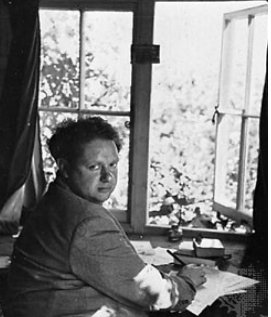 T he Dylan Thomas Walking Tour, guided by Ianto Robert, will take youto the Village places where thelegendary Welsh poet stayed, ate,drank, worked and performed, and towhere he finally died, while givingyou a feel for The Village in the 1950s.
T he Dylan Thomas Walking Tour, guided by Ianto Robert, will take youto the Village places where thelegendary Welsh poet stayed, ate,drank, worked and performed, and towhere he finally died, while givingyou a feel for The Village in the 1950s.
- When: Sunday mornings weekly from March 2011
- Time: 11:00 AM, Check current schedule
- Duration: Approximately 2 hours
- Cost: $25.00 per ticket
- Weather: Tour takes place rain or shine
Tickets should be purchased in advance at
Or phone (USA) 0012122093370
Please refer to activity # 1213
This is the Official Dylan Thomas Walking Tour of NewYork. Originally written by Peter Thabit Jones through acollaboration of the Welsh Assembly Government in NewYork and the family of Dylan Thomas.
In Memoriam
Of Dylans daughter Aeronwy whoconfirmed the research and walked outthe tour.

